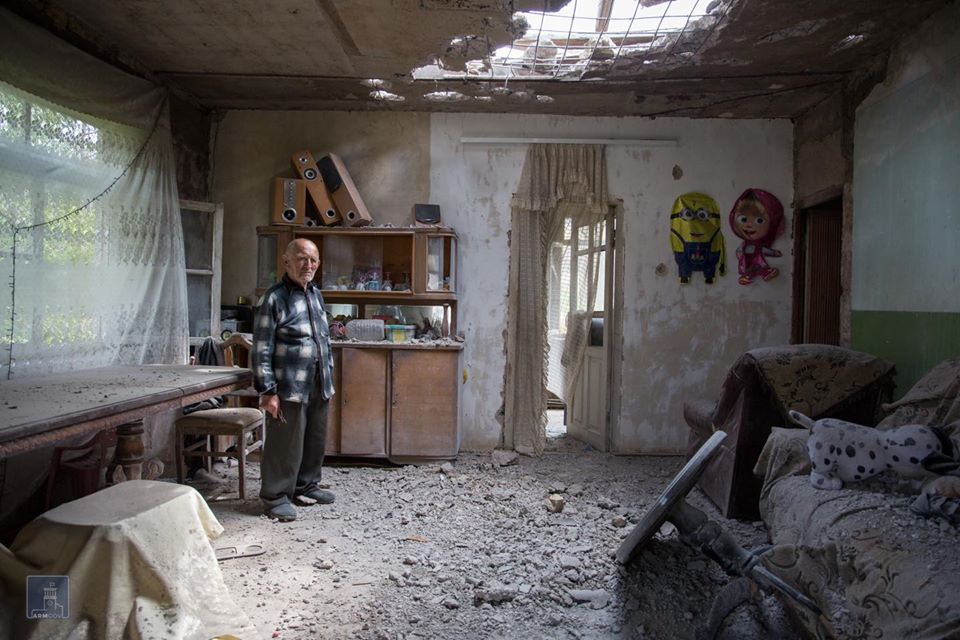
Nothing sums up the contrast in contributions to our global society of Armenia and Azerbaijan more than this phrase. It is borrowed from several current recovery campaigns such as the Paros Foundation and my good friend, their executive director Peter Abajian. Since 2006 the Paros Foundation, like many other patriotic nonprofits, has worked tirelessly to improve the quality of life of the citizens of Armenia and Artsakh. Much of their incredible work in schools and infrastructure has been in the Tavush region, the current hotspot of Azerbaijani madness. The contrast in core values is why the Armenians have endured the hardships of unilateral attacks and why the latest aggression against Armenia will fail.
Armenians have seen this movie too many times. A small Christian nation, the indigenous population of its multi-millennia homeland is attacked, blockaded and subjected to relentless abuse by barbaric newcomers. Even though the Turks have now been in the region about 1,000 years, to the Armenians, Assyrians and Greeks, they are shallow rooted. This applies also to their treacherous cousins to the west called Azerbaijan. They attack Artsakh and Tavush and have the audacity to “claim” the Republic of Armenia. Despite signing treaties that recognize the sovereign state and international borders of Armenia, Azerbaijani self-interest intersects with criminal behavior. Essentially, with every rant of rhetoric and military incursion, they are violating international laws. But then again, they are only modeling their behavior after their big cousin currently occupying Western Armenia, who has violated the sovereignty of Syria, Iraq and Cyprus and is very close to adding Libya to the list. Yet they are a “valued ally in NATO.” The behavior says a great deal about the integrity of international agreements.
Why will Azerbaijan fail? They are larger (nearly three times the population of Armenia) and wealthier (fortunate to have a desired fossil fuel supply) and in a world lacking political morals, they can buy the silence of many. So much for the bad news. Let’s start by looking at the national makeup of each country and how that impacts their commitment to achieving their objective.
Several years ago while in Artsakh, my family was given a tour of the Artsakh state museum by a remarkable young woman. Her tour work was not a job but a responsibility to educate…to tell the truth. She called Azerbaijan an “artificial nation” which is a phrase I have never forgotten and found to be a key weakness of Azerbaijan. It sits on oil, but also on a shaky foundation. Azerbaijan as a nation state did not exist before 1918. Its name is borrowed from a region in northern Iran. The nation called Azerbaijan and its ethnic makeup reveal a heterogeneous mix. The indigenous Caucasian Albanians were first converted to Islam under Arab and later Persian influence. The Seljuk Turkish invasion (11th century) brought the Turkic influence with language (Oghuz) and culture. Today although a majority are called ethnic Azerbaijani, it is a relatively new combination of multi-ethnic groups, Shia Islam with Turkish influence. There are significant minority groups such as the Lezgins and Talysh who have their own issues of free expression with the ethnic majority. Azerbaijan’s relatively short national history has little experience with democracy. Since its independence from 70 years of Soviet rule, it has been run by autocrats, the latest being the second generation of the corrupt Aliyev clan. When there are lives on the line, the shallow national roots of Azerbaijan will cause its citizens to question who and what they are fighting for.
No such problem with Armenia and Artsakh. Armenia is a study in homogeneity with over 98 percent of its citizens ethnic Armenians adhering to a Christian heritage and speaking a common language. They have also been the indigenous population of the area for centuries. Evidence of the Armenian civilization exists everywhere, except where Azerbaijani authorities have overtly sought to destroy the historic presence of Armenians. When we look at the enclave called Nagorno-Karabakh (as defined by the Soviets), it is really a scaled down version of the centuries old Armenian province of Artsakh. The seven liberated territories surrounding Nagorno-Karabakh (which are a part of the Republic of Artsakh) along with the still occupied northern Shahumyan and some eastern districts are the bulk of historic Artsakh, which dates back to the first millennia BC (Tigranes Metz). The Azeris’ claim of an historic population presence in Artsakh and the Stalin “award” in 1923 is the basis for their “territorial integrity” rights. The reality is that the demographic changes were forced migration and “artificial” attempts to dilute the Armenian homeland in the 18th to 20th centuries. The Stalin decision was an injustice but was also designated an “autonomous” region. It is not within any definition of “territorial integrity.” One cannot claim what was never theirs to own. A contributor to their continuous failure has been the lack of a substantive justification for their claims. Anyone can bully false claims, but sustaining a motivation with your citizens is entirely another challenge. Aliyev, in the absence of the truth, has propagandized a false narrative based on lies and hatred to feed his naive masses. Any national objective based on hate, anger and racism is not sustainable. This fuels the core motivation of the Azeris towards Artsakh and Armenia. Hatred is not an infinite rechargeable motivation.
This brings us to one of the core issues. What are the two sides fighting for? The Armenians are defending their homes and homeland. It doesn’t get much more personal than that. They are also defending the investment and sacrifices they have made. The departed lives of brothers, sisters, fathers and mothers must not be lost in vain. Since 1991, Artsakh has become a functioning democracy with a parliament and market-driven economy. This is a remarkable accomplishment given the blockades and unrecognized status. With each year of new housing, economic growth, historic preservations and culture, the people of Artsakh build on their core foundation. Remember that Armenians build. In stark contrast, since 1991, Azerbaijan has built their existence almost solely on their good fortune of fossil fuel. It has corrupted their entire economic, political and social existence. Azerbaijan has evolved into a dictatorship where self-preservation dominates and lies and hatred become commonplace. Over the last 30 years, despite the rhetoric of a “national liberation” effort to take Artsakh and Armenia proper, Azerbaijan has employed thousands of mercenaries from Chechens to Islamic terrorists. The latest move seems to be with Turks who are rumored to be sending terrorists from their northern Syrian adventure to Azerbaijan. They are also causing trouble in Nakhichevan where they have a small common border (compliments of Stalin). This is troubling but will also fail. Mercenaries get paid, as the economic base of Azerbaijan is diminishing.
Azerbaijan will never be a match for the landowners defending their families. The professional Armenian military of Armenia and Artsakh is the collateral to guarantee this mandate. They are the successors to Avarayr and Sardarabad where a different generation fought against overwhelming odds and succeeded. Like the Holy Muron of our faith, all these events are connected in spirit. This is the reality that expands the capability of the Armenians and will always limit Azerbaijanis.
Right now, Aliyev is likely betting on two things. He is counting on the world to remain indifferent either by buying silence or general ambivalence. He is also assuming that Armenia will blink and not respond to his provocations. On the former, this is our job in the diaspora to work with the homeland to prevent indifference in host nations. Sanctioning Azerbaijan, influencing political bodies and mounting public support are critical. In this country, the ANCA and the Armenian Assembly of America are busy in this regard. Never underestimate the importance of third parties. Aliyev was hoping that the emergence of a new government under Pashinyan would be more open to “compromise.” Pashinyan has shown himself to be stronger in his words and actions than his predecessors. He and the relevant ministries have been on the offensive diplomatically by countering Azeri rhetoric with substantive positions such as the return of Artsakh as a direct negotiating party. He has skillfully avoided undermining the OSCE mediators despite the frustration of their neutrality. Aliyev, on the other hand, has done everything to countermand their actions by ignoring confidence building measures (St. Petersburg, Vienna, etc.), continuing sniper fire, patronizing on-site support and launching at least two major assaults since 2016 with unprovoked action. Privately, their behavior is wearing thin with many and will one day pay a return. Despite the surface level material strength of Azerbaijan, a closer view shows why they have and will continue to underperform. It does not lessen the danger for the Armenians. It simply illustrates why a united Armenia will prevail.
Back to “We Build. They Destroy.” For most Armenians who are not directly involved in the military responses, the most important issue is to rebuild. The vitality of the border villages in Tavush, Artsakh, Ararat (including our beloved Paruyr Sevak), Vayots Dzor and Syunik are strategically important to the national security of our nation. The strongest message to Azeris is that their attempts are futile. Their activity is an attempt to destabilize the borders by intimidating the population to leave. We must immediately rebuild and make these villages even stronger economically. This is our job in the diaspora. You have all seen several emergency fundraisers by organizations such as Paros and individuals (our ardent patriot Anna Astvatsaturian Turcotte). We must meet and exceed the goals to BUILD and give a clear message to our brethren and the AZERBAIJANIS. We are not going anywhere. Our history has been a case study of overcoming oppression and prevailing. Today is no exception.



Aper, listen. “In a dramatic change, on December 1, 1920, Azerbaijan publicly decreed that Karabakh, Nakichevan, and Zangezur belonged to Armenia. But then, the Soviet Union incorporated the Independent Republic of Armenia, and the status of Karabakh became unsettled. In February 1921, the Armenians staged a brief, successful revolt against Soviet rule, but ultimately the Soviet armies prevailed. In 1921, pursuant to an agreement between Stalin and Turkey, the geographically, demographically, and historically Armenian territories of Nagorno-Karabakh and Nakichevan were awarded to Azerbakjani rule. These decisions were recognized in the Treaties of Moscow and Kars, treaties signed without legitimate representation of the Armenian majority.” Page 666 can be found here… https://www.google.com/books/edition/The_Future_of_Europe/-Se9z_9F2UUC?hl=en&gbpv=1&dq=soviet%20union%20promised%20karabakh%20to%20turkey&pg=PA666&printsec=frontcover&bsq=soviet%20union%20promised%20karabakh%20to%20turkey
The United States has acknowledged the legitimacy of Artsakh, the illegitimacy of Turkey’s authority over Artsakh, and even acknowledged that the “majority Armenians” weren’t present when the treaty was signed between Stalin and Turkey. Yet today, the USA doesn’t acknowledge the Republic of Artsakh. Page 666 will be cited for years to come.
Thanks for always keeping us informed and hopeful for the border safety of Artsakh, Tavush etc. As you mention,the present military of Armenia & Artsakh are the successors of the Avarayr& Sardarabad generation, and like them, united in faith, Spirit and courage,they will defend their borders to maintain safety of their homes and their land. Let’s be in united prayer for God’s protection and the victory of our soldiers.